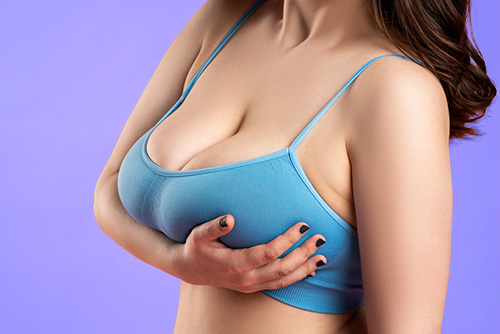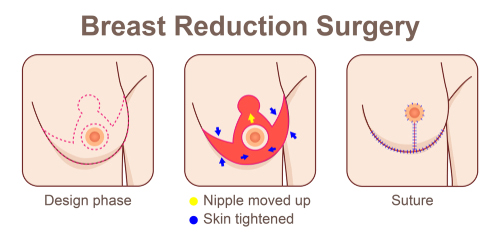Breast Reduction Surgery in Turkey, Costs Procedure and Details

- Breast Reduction Cost Turkey vs Europe
- Breast Reduction Surgery Procedure
- Breast Reduction Surgery Process
- After Breast Reduction Surgery
- Breast Reduction Without Surgery
- Risks of Breast Reduction Surgery
- When to consider breast reduction surgery?
- What should be considered when deciding to have a breast reduction?
- Breast Reduction For Man
The female breast consists of fatty and connective tissue and a mammary gland with milk ducts that lead to the nipple. The size and shape of breasts varies from woman to woman. This is influenced by genetic predisposition, physique, weight and hormonal balance.
For some women, the breasts are so large that the bust size becomes a physical or mental burden. Sometimes only a surgical reduction of the breasts helps (the technical term for a breast reduction is mammary reduction or plastic mammary reduction). During the operation, the surgeon reduces the volume of one or both breasts, often tightening the skin during the procedure. You can find all the important facts about breast reduction here:
Breast Reduction Cost Turkey vs Europe
The cost of a breast reduction operation is between 4,000 and 7,500 euros in europe. The price depends on various factors such as the scope of the procedure, the surgical method and whether the surgeon also performs a skin tightening.If the operation is only for aesthetic reasons, the health insurance companies usually do not pay for the treatment. There are the following requirements for reimbursement:

When a woman has very large breasts (meaning the surgery requires at least 500 grams of tissue to be removed from each breast or at least two bra cup sizes) and there is a medical need for the procedure. This is the case, for example, if she has postural problems and back pain because of her heavy breasts. A medical certificate, for example from an orthopaedist, must confirm this.
If the breasts are noticeably different in size or have a clear malformation.
When a woman suffers mentally because of her breasts, for example because she is often stared at because of her large breasts and hears suggestive comments. Here, too, a medical report (from a psychiatrist) must prove that the patient suffers mentally from the large bust size.
Breast Reduction Surgery Procedure
| Duration | Two to four hours |
| Anesthetic Type | General anesthesia |
| Hospital Stay | Two to seven days |
Before The Breast Reduction Surgery
If a woman has decided to have a breast reduction, she should definitely choose a good clinic for the procedure, which has experienced surgeons who have performed this surgery many times. Surgery is a craft and the following applies: the more often a doctor has performed the operation, the better he has mastered the procedure. Before the operation, a detailed consultation should definitely take place, in which the patient describes why she would like to have her breasts reduced and how she imagines her breasts to be after the operation. The surgeon then explains what result is possible, which surgical method makes sense and what the risks of the procedure are.
In addition, the doctor usually performs a mammography on the patient before the procedure so that the specialist can get a detailed picture of the structure of the woman's breast tissue and also be able to rule out a tumor.
Breast Reduction Surgery Process
Doctors perform the procedure in the hospital. Depending on the scope of the operation, it takes about two to four hours. The patient is given general anesthesia. During surgery, the surgeon removes excess glandular, fatty and skin tissue from the breast and then forms a new breast from the remaining tissue. With some surgical methods, the nipple and areola, together with the nerves and blood vessels, are moved upwards. Breast reduction often involves tightening the breast and reducing the size of the areolae.
The surgeon has various surgical techniques at his disposal. They differ in where the doctor places the incisions on the torso. Which method is most suitable depends, among other things, on the amount of tissue to be removed, the size and position of the nipple and the shape of the chest.
The following surgical techniques can be used:
- T-cut method (also called the Strömbeck method, after the inventor of this surgical method: surgeon Jan O. Strömbeck): The surgeon cuts around the areola with a scalpel and then makes the cut vertically from the lower area of the nipple down to the infrabust crease. There it intersects a horizontal line to the left and to the right. This creates a cut that looks like an upside down “T”.
The disadvantage of this incision technique is that the nipple is shifted upwards. Especially with very large breasts, it may be necessary to completely detach the nipple and then reinsert it. This can result in a loss of the ability to breastfeed and a sensory disturbance in the nipple.
- L-cut method: This is performed on the same principle as the T-cut. The difference is that the surgeon only makes the horizontal incision from the inframammary fold to one side and the skin incision (and thus later the scar) is therefore slightly smaller. A larger amount of breast tissue can also be removed with the L-incision. To remove excess skin, the surgeon can also make a short incision on the other side, which experts then call a "small T-incision".
- I-cut method (also called the Lejour method, after the surgeon Madeleine Lejour, who developed this surgical technique): The surgeon cuts around the nipple and, like the T-cut, guides the scalpel vertically down to the lower breast crease. However, he does not make a horizontal cut there. He only removes the excess skin along the vertical incision and also tightens the skin in the process. The method is recommended if the breast is to be lifted during the procedure.

❶ Excess skin is removed, the nipple is shifted upwards
❷ The surgeon reshapes the glandular tissue, tightens and stitches the skin
❸ Scars around the areola and on the incision fade and can hardly be seen after one to two years
- O-Method (also known as the Benelli method; named after the surgeon Louis Benelli who invented this surgical technique): With this technique, the surgeon limits himself to a circular incision around the nipple. He then removes the excess breast tissue through this small opening. This means that there are few scars, but because only a small amount of tissue can be removed in this way, the method is only suitable for minor breast changes.
- Hall-Findlay method: This incision technique was developed in 1999 by the surgeon Elisabeth Hall-Findlay. The advantage of this method is that it allows for the greatest possible protection of the nipple. This is because the surgeon does not separate the nipple when moving it, but it remains connected to the mammary gland via its so-called pedicle during the procedure. This preserves the blood flow to the nipple and most likely also the ability to breastfeed and the sensitivity of the nipple. The excess breast tissue is removed via a vertical incision from the nipple to the submammary crease.
After Breast Reduction Surgery
Depending on the extent of the operation, a subsequent hospital stay of around two to seven days is necessary. The wound drains that the surgeon uses during the operation to drain blood and tissue fluid can usually be removed after one to three days. Doctors remove the threads ten to fourteen days after the procedure. There are also sutures that dissolve by themselves after a certain period of time.
Healing Process After Breast Reduction Surgery
Swelling, discolouration and pain in the breasts can occur in the first few days after the operation. This is normal and usually goes away after a while. A pain reliever can be taken to relieve the pain. Since the healing process takes some time, the final result of the procedure is usually not visible until three to six months later.
Immediately after the operation, the patient is given a pressure bandage, which is replaced by a medical bra (also known as a support bra) after a few days. The bra applies even pressure to the breasts, preventing excessive scarring and protecting the breasts as they heal. Therefore, the patient should wear the support bra 24 hours a day for the first six weeks.
The operated breasts should be largely spared in the first two months after the operation. This includes that patients do not sleep on their stomachs or sides, but on their backs, and that they absolutely refrain from physical activities that strain the chest, upper arms and shoulder girdle. Therefore, sport is also taboo during this time. In addition, the patient should discuss with her treating doctor what she should explicitly consider in everyday life.
In order not to disrupt the wound healing process, patients should also, avoid sunbathing (including solariums) indoors for the first three months after the procedure, do not go to the sauna and avoid smoking and alcohol if possible.
Depending on the extent of the operation, the patient is able to work again after three to six weeks. However, this depends on whether the job is physically demanding or whether it is an office job.
Scar Care After Breast Reduction Surgery
Scars may appear after the operation. Careful aftercare can significantly improve the healing process. After the stitches have been removed, the scars should be creamed daily (e.g. with a cream containing dexpanthenol). Once the wounds have healed completely, scar massage can also be used: the patient applies a small amount of cream (unscented) to the scar and then uses her fingertips to apply gentle pressure in circular movements along the scar for five to ten minutes. The massage should be practiced two to three times a day. Silicone gels or plasters support the maturation of the scars and promote a beautiful scar appearance.Breast Reduction Without Surgery
Women who only have slightly larger breasts may be able to reduce their breast size somewhat through regular exercise and a conscious diet. Targeted muscle training, such as lying up, can also strengthen the chest muscles and firm and tighten the bust size.
Risks of Breast Reduction Surgery
As with any surgical procedure, there are some risks involved with breast reduction. Possible complications include:
- Bleeding
- Bruising and swelling
- Blood clots that break off as a result of surgery and can lead to thrombosis and embolism
- Infection
- Wound healing disorders
- An asymmetry of the operated breasts or the transferred nipples
- Nipple death (doctors call this necrosis)
- Anesthetic complications
- Significant scarring
Breastfeeding after breast reduction
One of the possible complications of a breast reduction is that the operation can result in a loss of the ability to breastfeed. Women who want to have children or whose family planning has not yet been completed should consider this and postpone the procedure until later after pregnancy and breastfeeding.
When to consider breast reduction surgery?
At what size is a breast considered too full? On average, a woman's breast weighs between 150 grams and 400 grams (per side). In some medical textbooks, a breast weighing more than 1,000 grams (per side) is referred to as macromastia (excessively large breast).
However, many specialists reject such a categorization because it does not take into account the individual physique and height of a woman. For example, for a 1.60 meter tall, petite woman, a breast weight of 500 grams can already be too much and put a physical and/or psychological strain on her, and a 1.80 meter tall woman may find this breast size ideal. After all, every woman judges according to her own feelings whether she classifies her breasts as "normal" or too large.
So when is a breast reduction recommended? This mainly depends on whether a woman suffers physically and/or mentally from her large bust size:
Breast reduction due to physical problems
If the breast is very large, the heavy weight (large breasts can weigh up to two kilos per side in extreme cases) can cause some women to bend their upper body slightly forward and develop a rounded back.The bent posture can cause back pain, neck tension and headaches. Since large breasts can be uncomfortable during some sporting activities such as jogging or tennis, they limit the freedom of movement of those affected and thus increase existing symptoms.
Postural damage can also promote signs of wear and tear in the spine, which sometimes lead to herniated discs. Skin problems also often occur with sagging breasts: If the breasts lie on the upper abdominal area, sweat often occurs in the lower breast crease and thus a warm, humid environment in which germs can settle. Eczema or a fungal infection can also occur in the lower breast crease.
Breast reduction because of aesthetic problems
Large breasts can also mean psychological stress for women. Some suffer greatly.
In addition, some women believe that too large a bust does not look aesthetic and reduces attractiveness. In addition, with age, the breasts can become larger again as a result of the hormonal boost caused by menopause and also lose their firmness and droop. Some women feel so uncomfortable in their bodies because of their voluminous breasts that their self-confidence suffers and they are ashamed to be naked in front of their partner and not be able to enjoy their sex life.
Buying clothes can also be more difficult, as large bras are often only available in expensive lingerie stores and some textiles do not look good on larger breasts.
Breast reduction after breast cancer
Another reason for a breast reduction is when after breast cancer surgery the breasts are asymmetrical or of different sizes and need to be adjusted.
What should be considered when deciding to have a breast reduction?
A prerequisite for the procedure is that the patient's body growth is complete and the breasts are fully developed. If this is the case, a breast reduction is in principle possible at any age.
However, it should be borne in mind that breast reduction can result in a loss of the ability to breastfeed. Every patient who still wants to have children or whose family planning has not yet been completed should consider this. If the woman has just given birth, she should wait until her breasts have returned to normal (at least 8 months after she stopped breastfeeding) to perform surgery.
Breast Reduction For Man
Men can get feminine looking breasts too. A disturbance in the hormonal balance, such as a lack of testosterone, is usually the cause of the benign enlargement of the mammary gland tissue in men. Doctors refer to this as gynecomastia. But obesity and fat deposits in the male breast can also be the reason for the "man's breast". In this case, doctors speak of lipomastia or pseudogynecomastia. In some cases, breast reduction surgery is necessary. The procedure takes one and a half to two hours, and the patient is usually given general anesthesia. To read more about gynecomastia surgery please click here.There are no comments yet. Would you like to add a comment?
In accordance with Article 10 of the Personal Data Protection Law (PDPL,KVKK) titled Data Controller's Obligation to Disclose, we use cookies in accordance with the legislation, limited to the purposes specified in the privacy policy.

